Executive Summary: Tesla Lithium-Ion Battery Project Charter Details
VerifiedAdded on 2024/06/03
|18
|4051
|292
Project
AI Summary
This document presents an executive summary of a project charter focused on Tesla's initiative to develop a 100 MWh lithium-ion battery pack for the State Government of Southern Australia, aimed at reducing blackouts and supporting electricity shortfalls. The project goal is to complete the battery development within 100 days, ensuring stability in electrical grids and providing emergency backup. Key milestones include project initiation, raw material collection, battery design, manufacturing, testing, transportation, installation, and final testing. The project requirements cover raw materials, team member roles, and budget allocations. The work breakdown schedule details the tasks, start and end dates, and durations for each project stage. Time and cost management strategies are outlined, emphasizing regular meetings, strategic scheduling, and wise resource allocation. The project manager is responsible for cost control, performance evaluation, and managing resource allocation. Risk management and communication plans are also addressed, ensuring project success and stakeholder satisfaction. Desklib offers a variety of resources, including past papers and solved assignments, to support students in similar projects.

Assignment 2: Project Charter
Paraphrase This Document
Need a fresh take? Get an instant paraphrase of this document with our AI Paraphraser
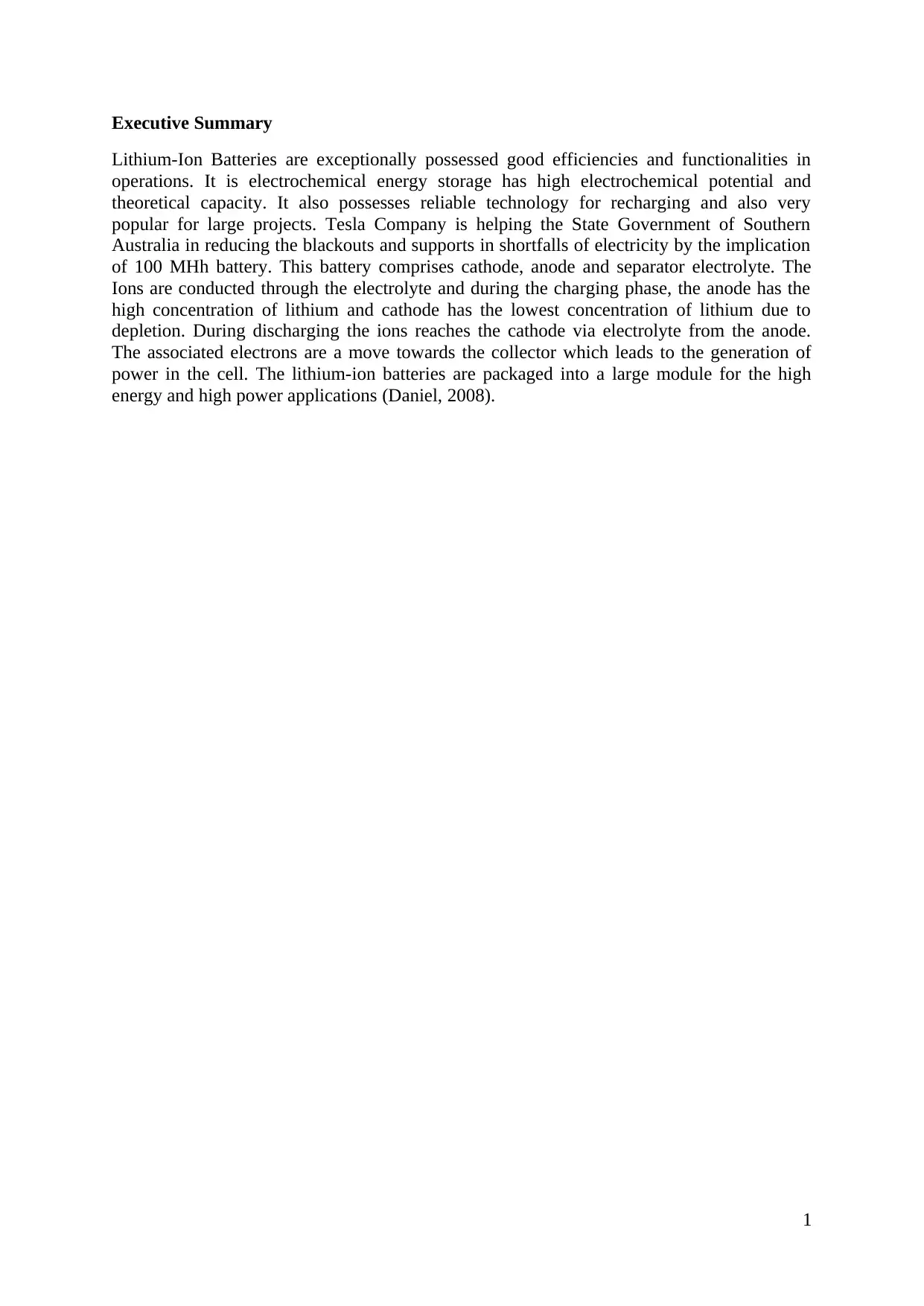
Executive Summary
Lithium-Ion Batteries are exceptionally possessed good efficiencies and functionalities in
operations. It is electrochemical energy storage has high electrochemical potential and
theoretical capacity. It also possesses reliable technology for recharging and also very
popular for large projects. Tesla Company is helping the State Government of Southern
Australia in reducing the blackouts and supports in shortfalls of electricity by the implication
of 100 MHh battery. This battery comprises cathode, anode and separator electrolyte. The
Ions are conducted through the electrolyte and during the charging phase, the anode has the
high concentration of lithium and cathode has the lowest concentration of lithium due to
depletion. During discharging the ions reaches the cathode via electrolyte from the anode.
The associated electrons are a move towards the collector which leads to the generation of
power in the cell. The lithium-ion batteries are packaged into a large module for the high
energy and high power applications (Daniel, 2008).
1
Lithium-Ion Batteries are exceptionally possessed good efficiencies and functionalities in
operations. It is electrochemical energy storage has high electrochemical potential and
theoretical capacity. It also possesses reliable technology for recharging and also very
popular for large projects. Tesla Company is helping the State Government of Southern
Australia in reducing the blackouts and supports in shortfalls of electricity by the implication
of 100 MHh battery. This battery comprises cathode, anode and separator electrolyte. The
Ions are conducted through the electrolyte and during the charging phase, the anode has the
high concentration of lithium and cathode has the lowest concentration of lithium due to
depletion. During discharging the ions reaches the cathode via electrolyte from the anode.
The associated electrons are a move towards the collector which leads to the generation of
power in the cell. The lithium-ion batteries are packaged into a large module for the high
energy and high power applications (Daniel, 2008).
1
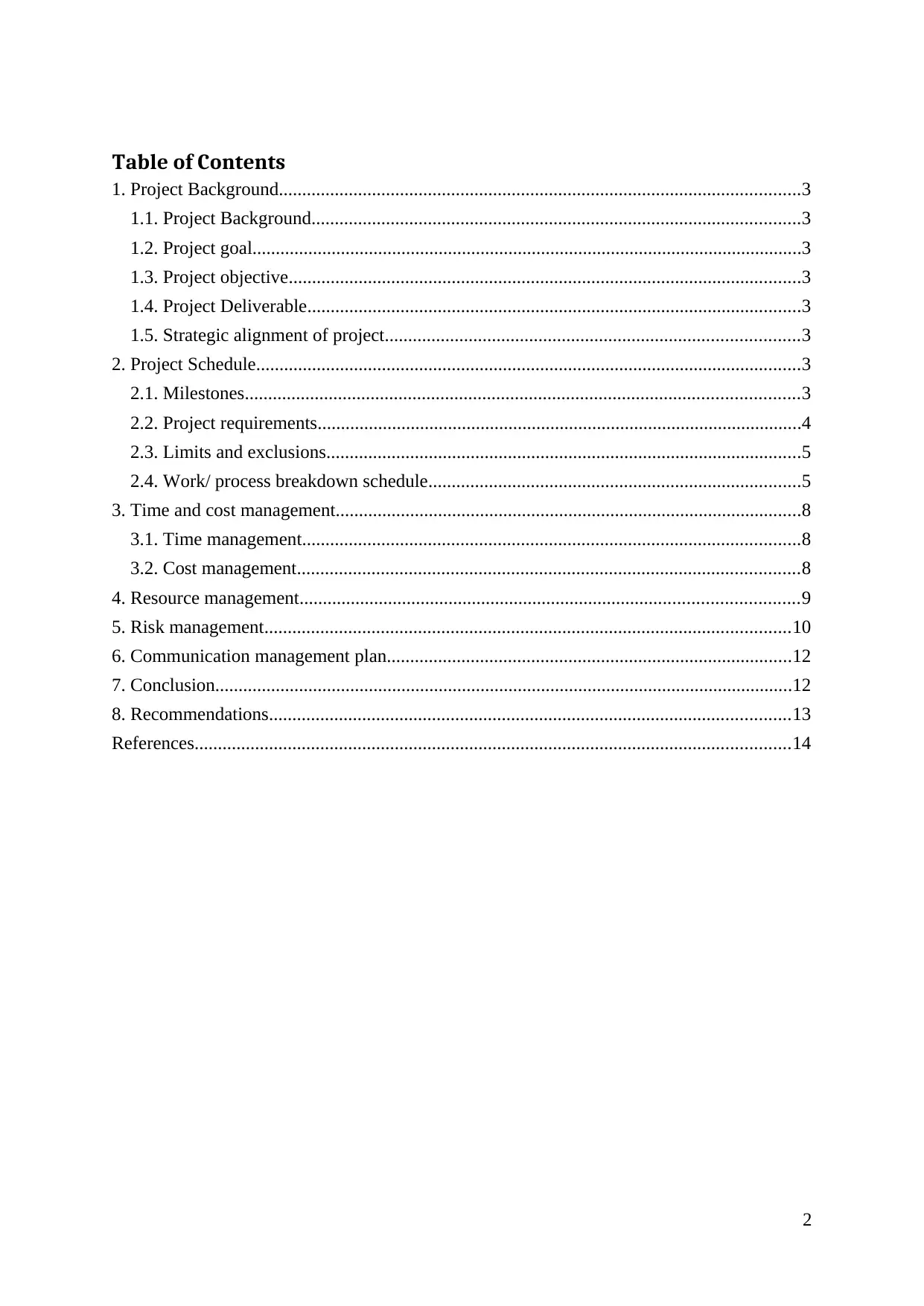
Table of Contents
1. Project Background................................................................................................................3
1.1. Project Background.........................................................................................................3
1.2. Project goal......................................................................................................................3
1.3. Project objective..............................................................................................................3
1.4. Project Deliverable..........................................................................................................3
1.5. Strategic alignment of project.........................................................................................3
2. Project Schedule.....................................................................................................................3
2.1. Milestones.......................................................................................................................3
2.2. Project requirements........................................................................................................4
2.3. Limits and exclusions......................................................................................................5
2.4. Work/ process breakdown schedule................................................................................5
3. Time and cost management....................................................................................................8
3.1. Time management...........................................................................................................8
3.2. Cost management............................................................................................................8
4. Resource management...........................................................................................................9
5. Risk management.................................................................................................................10
6. Communication management plan.......................................................................................12
7. Conclusion............................................................................................................................12
8. Recommendations................................................................................................................13
References................................................................................................................................14
2
1. Project Background................................................................................................................3
1.1. Project Background.........................................................................................................3
1.2. Project goal......................................................................................................................3
1.3. Project objective..............................................................................................................3
1.4. Project Deliverable..........................................................................................................3
1.5. Strategic alignment of project.........................................................................................3
2. Project Schedule.....................................................................................................................3
2.1. Milestones.......................................................................................................................3
2.2. Project requirements........................................................................................................4
2.3. Limits and exclusions......................................................................................................5
2.4. Work/ process breakdown schedule................................................................................5
3. Time and cost management....................................................................................................8
3.1. Time management...........................................................................................................8
3.2. Cost management............................................................................................................8
4. Resource management...........................................................................................................9
5. Risk management.................................................................................................................10
6. Communication management plan.......................................................................................12
7. Conclusion............................................................................................................................12
8. Recommendations................................................................................................................13
References................................................................................................................................14
2
⊘ This is a preview!⊘
Do you want full access?
Subscribe today to unlock all pages.

Trusted by 1+ million students worldwide
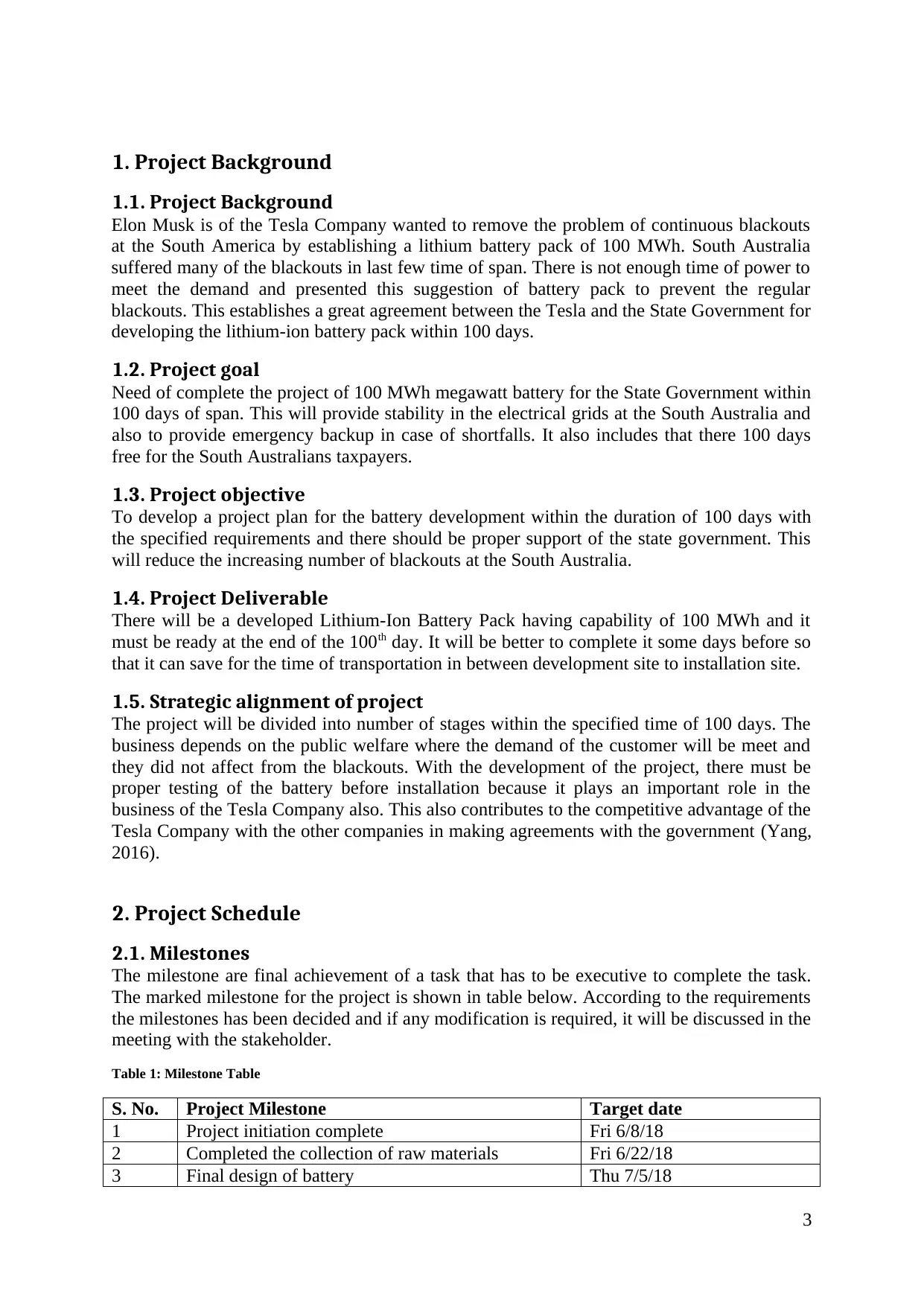
1. Project Background
1.1. Project Background
Elon Musk is of the Tesla Company wanted to remove the problem of continuous blackouts
at the South America by establishing a lithium battery pack of 100 MWh. South Australia
suffered many of the blackouts in last few time of span. There is not enough time of power to
meet the demand and presented this suggestion of battery pack to prevent the regular
blackouts. This establishes a great agreement between the Tesla and the State Government for
developing the lithium-ion battery pack within 100 days.
1.2. Project goal
Need of complete the project of 100 MWh megawatt battery for the State Government within
100 days of span. This will provide stability in the electrical grids at the South Australia and
also to provide emergency backup in case of shortfalls. It also includes that there 100 days
free for the South Australians taxpayers.
1.3. Project objective
To develop a project plan for the battery development within the duration of 100 days with
the specified requirements and there should be proper support of the state government. This
will reduce the increasing number of blackouts at the South Australia.
1.4. Project Deliverable
There will be a developed Lithium-Ion Battery Pack having capability of 100 MWh and it
must be ready at the end of the 100th day. It will be better to complete it some days before so
that it can save for the time of transportation in between development site to installation site.
1.5. Strategic alignment of project
The project will be divided into number of stages within the specified time of 100 days. The
business depends on the public welfare where the demand of the customer will be meet and
they did not affect from the blackouts. With the development of the project, there must be
proper testing of the battery before installation because it plays an important role in the
business of the Tesla Company also. This also contributes to the competitive advantage of the
Tesla Company with the other companies in making agreements with the government (Yang,
2016).
2. Project Schedule
2.1. Milestones
The milestone are final achievement of a task that has to be executive to complete the task.
The marked milestone for the project is shown in table below. According to the requirements
the milestones has been decided and if any modification is required, it will be discussed in the
meeting with the stakeholder.
Table 1: Milestone Table
S. No. Project Milestone Target date
1 Project initiation complete Fri 6/8/18
2 Completed the collection of raw materials Fri 6/22/18
3 Final design of battery Thu 7/5/18
3
1.1. Project Background
Elon Musk is of the Tesla Company wanted to remove the problem of continuous blackouts
at the South America by establishing a lithium battery pack of 100 MWh. South Australia
suffered many of the blackouts in last few time of span. There is not enough time of power to
meet the demand and presented this suggestion of battery pack to prevent the regular
blackouts. This establishes a great agreement between the Tesla and the State Government for
developing the lithium-ion battery pack within 100 days.
1.2. Project goal
Need of complete the project of 100 MWh megawatt battery for the State Government within
100 days of span. This will provide stability in the electrical grids at the South Australia and
also to provide emergency backup in case of shortfalls. It also includes that there 100 days
free for the South Australians taxpayers.
1.3. Project objective
To develop a project plan for the battery development within the duration of 100 days with
the specified requirements and there should be proper support of the state government. This
will reduce the increasing number of blackouts at the South Australia.
1.4. Project Deliverable
There will be a developed Lithium-Ion Battery Pack having capability of 100 MWh and it
must be ready at the end of the 100th day. It will be better to complete it some days before so
that it can save for the time of transportation in between development site to installation site.
1.5. Strategic alignment of project
The project will be divided into number of stages within the specified time of 100 days. The
business depends on the public welfare where the demand of the customer will be meet and
they did not affect from the blackouts. With the development of the project, there must be
proper testing of the battery before installation because it plays an important role in the
business of the Tesla Company also. This also contributes to the competitive advantage of the
Tesla Company with the other companies in making agreements with the government (Yang,
2016).
2. Project Schedule
2.1. Milestones
The milestone are final achievement of a task that has to be executive to complete the task.
The marked milestone for the project is shown in table below. According to the requirements
the milestones has been decided and if any modification is required, it will be discussed in the
meeting with the stakeholder.
Table 1: Milestone Table
S. No. Project Milestone Target date
1 Project initiation complete Fri 6/8/18
2 Completed the collection of raw materials Fri 6/22/18
3 Final design of battery Thu 7/5/18
3
Paraphrase This Document
Need a fresh take? Get an instant paraphrase of this document with our AI Paraphraser
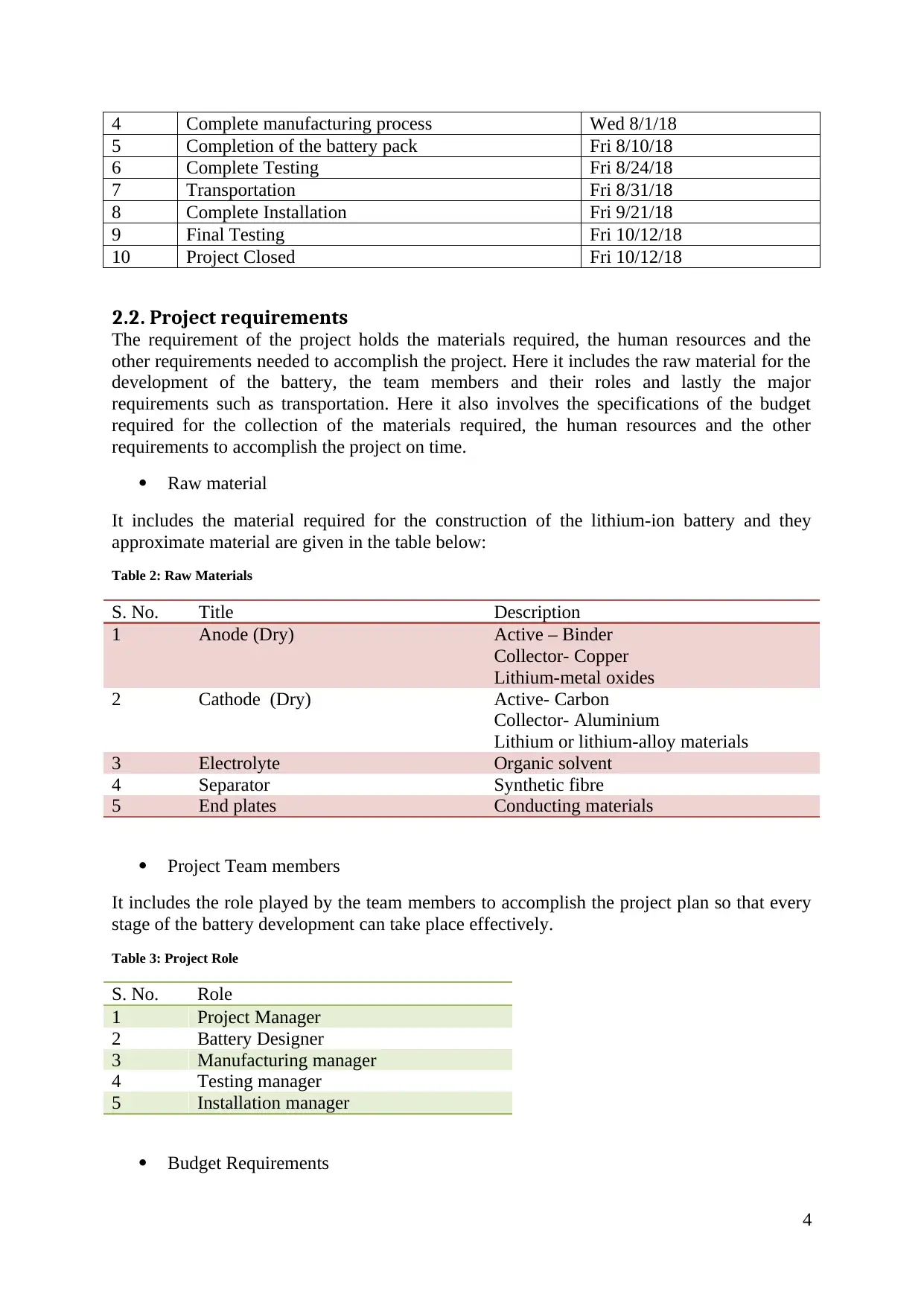
4 Complete manufacturing process Wed 8/1/18
5 Completion of the battery pack Fri 8/10/18
6 Complete Testing Fri 8/24/18
7 Transportation Fri 8/31/18
8 Complete Installation Fri 9/21/18
9 Final Testing Fri 10/12/18
10 Project Closed Fri 10/12/18
2.2. Project requirements
The requirement of the project holds the materials required, the human resources and the
other requirements needed to accomplish the project. Here it includes the raw material for the
development of the battery, the team members and their roles and lastly the major
requirements such as transportation. Here it also involves the specifications of the budget
required for the collection of the materials required, the human resources and the other
requirements to accomplish the project on time.
Raw material
It includes the material required for the construction of the lithium-ion battery and they
approximate material are given in the table below:
Table 2: Raw Materials
S. No. Title Description
1 Anode (Dry) Active – Binder
Collector- Copper
Lithium-metal oxides
2 Cathode (Dry) Active- Carbon
Collector- Aluminium
Lithium or lithium-alloy materials
3 Electrolyte Organic solvent
4 Separator Synthetic fibre
5 End plates Conducting materials
Project Team members
It includes the role played by the team members to accomplish the project plan so that every
stage of the battery development can take place effectively.
Table 3: Project Role
S. No. Role
1 Project Manager
2 Battery Designer
3 Manufacturing manager
4 Testing manager
5 Installation manager
Budget Requirements
4
5 Completion of the battery pack Fri 8/10/18
6 Complete Testing Fri 8/24/18
7 Transportation Fri 8/31/18
8 Complete Installation Fri 9/21/18
9 Final Testing Fri 10/12/18
10 Project Closed Fri 10/12/18
2.2. Project requirements
The requirement of the project holds the materials required, the human resources and the
other requirements needed to accomplish the project. Here it includes the raw material for the
development of the battery, the team members and their roles and lastly the major
requirements such as transportation. Here it also involves the specifications of the budget
required for the collection of the materials required, the human resources and the other
requirements to accomplish the project on time.
Raw material
It includes the material required for the construction of the lithium-ion battery and they
approximate material are given in the table below:
Table 2: Raw Materials
S. No. Title Description
1 Anode (Dry) Active – Binder
Collector- Copper
Lithium-metal oxides
2 Cathode (Dry) Active- Carbon
Collector- Aluminium
Lithium or lithium-alloy materials
3 Electrolyte Organic solvent
4 Separator Synthetic fibre
5 End plates Conducting materials
Project Team members
It includes the role played by the team members to accomplish the project plan so that every
stage of the battery development can take place effectively.
Table 3: Project Role
S. No. Role
1 Project Manager
2 Battery Designer
3 Manufacturing manager
4 Testing manager
5 Installation manager
Budget Requirements
4
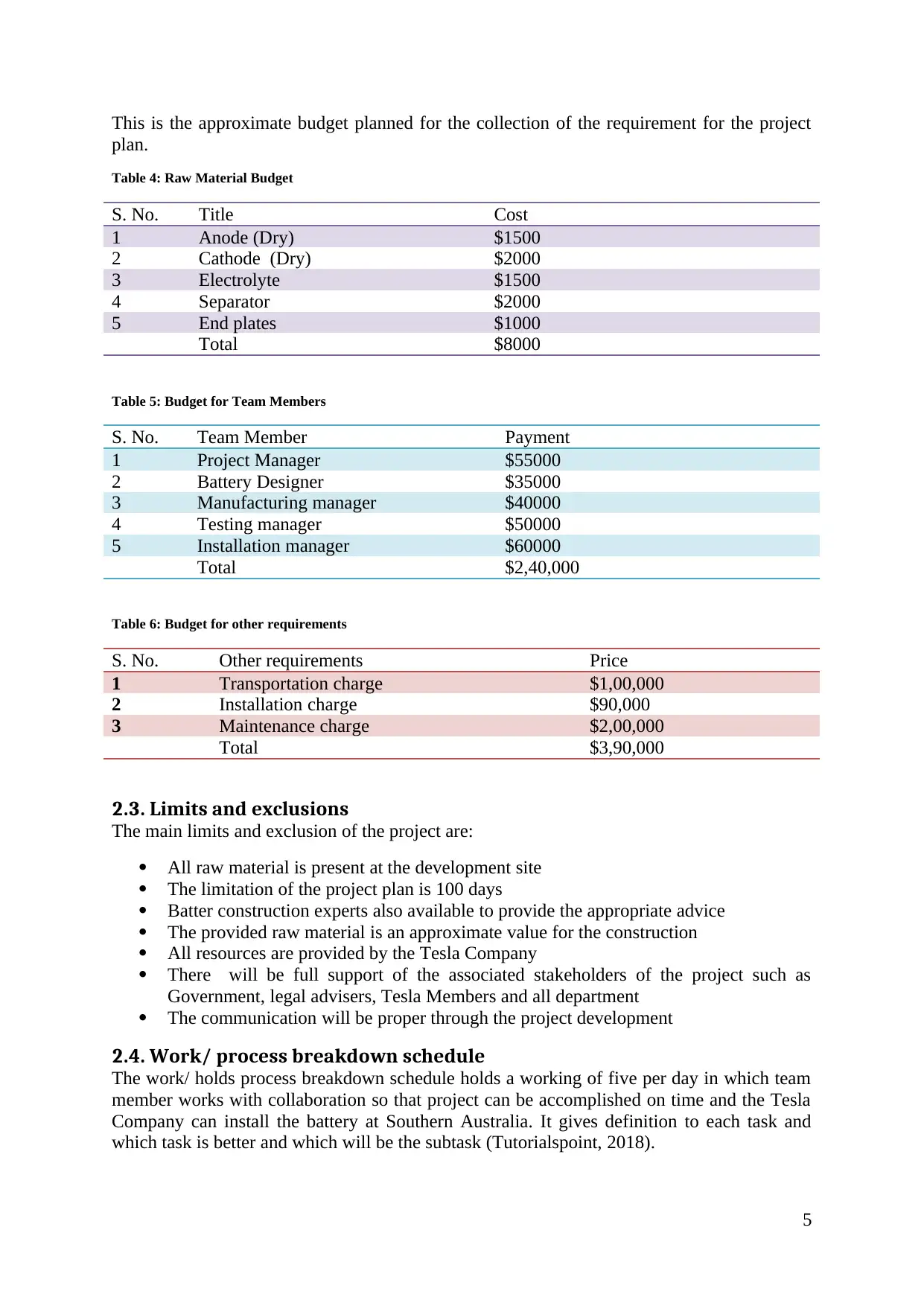
This is the approximate budget planned for the collection of the requirement for the project
plan.
Table 4: Raw Material Budget
S. No. Title Cost
1 Anode (Dry) $1500
2 Cathode (Dry) $2000
3 Electrolyte $1500
4 Separator $2000
5 End plates $1000
Total $8000
Table 5: Budget for Team Members
S. No. Team Member Payment
1 Project Manager $55000
2 Battery Designer $35000
3 Manufacturing manager $40000
4 Testing manager $50000
5 Installation manager $60000
Total $2,40,000
Table 6: Budget for other requirements
S. No. Other requirements Price
1 Transportation charge $1,00,000
2 Installation charge $90,000
3 Maintenance charge $2,00,000
Total $3,90,000
2.3. Limits and exclusions
The main limits and exclusion of the project are:
All raw material is present at the development site
The limitation of the project plan is 100 days
Batter construction experts also available to provide the appropriate advice
The provided raw material is an approximate value for the construction
All resources are provided by the Tesla Company
There will be full support of the associated stakeholders of the project such as
Government, legal advisers, Tesla Members and all department
The communication will be proper through the project development
2.4. Work/ process breakdown schedule
The work/ holds process breakdown schedule holds a working of five per day in which team
member works with collaboration so that project can be accomplished on time and the Tesla
Company can install the battery at Southern Australia. It gives definition to each task and
which task is better and which will be the subtask (Tutorialspoint, 2018).
5
plan.
Table 4: Raw Material Budget
S. No. Title Cost
1 Anode (Dry) $1500
2 Cathode (Dry) $2000
3 Electrolyte $1500
4 Separator $2000
5 End plates $1000
Total $8000
Table 5: Budget for Team Members
S. No. Team Member Payment
1 Project Manager $55000
2 Battery Designer $35000
3 Manufacturing manager $40000
4 Testing manager $50000
5 Installation manager $60000
Total $2,40,000
Table 6: Budget for other requirements
S. No. Other requirements Price
1 Transportation charge $1,00,000
2 Installation charge $90,000
3 Maintenance charge $2,00,000
Total $3,90,000
2.3. Limits and exclusions
The main limits and exclusion of the project are:
All raw material is present at the development site
The limitation of the project plan is 100 days
Batter construction experts also available to provide the appropriate advice
The provided raw material is an approximate value for the construction
All resources are provided by the Tesla Company
There will be full support of the associated stakeholders of the project such as
Government, legal advisers, Tesla Members and all department
The communication will be proper through the project development
2.4. Work/ process breakdown schedule
The work/ holds process breakdown schedule holds a working of five per day in which team
member works with collaboration so that project can be accomplished on time and the Tesla
Company can install the battery at Southern Australia. It gives definition to each task and
which task is better and which will be the subtask (Tutorialspoint, 2018).
5
⊘ This is a preview!⊘
Do you want full access?
Subscribe today to unlock all pages.

Trusted by 1+ million students worldwide
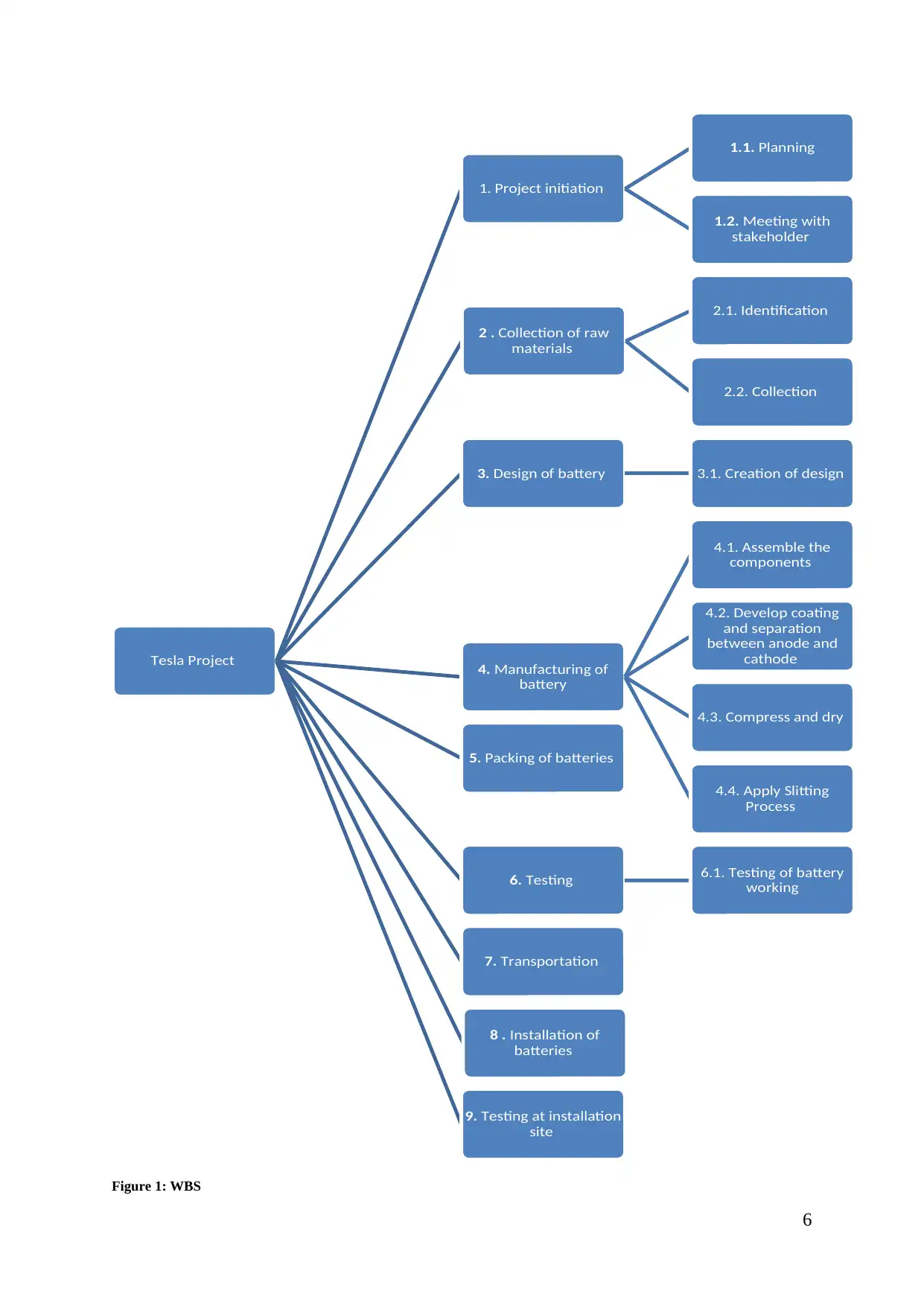
Figure 1: WBS
6
Tesla Project
1. Project initiation
1.1. Planning
1.2. Meeting with
stakeholder
2 . Collection of raw
materials
2.1. Identification
2.2. Collection
3. Design of battery 3.1. Creation of design
4. Manufacturing of
battery
4.1. Assemble the
components
4.2. Develop coating
and separation
between anode and
cathode
4.3. Compress and dry
4.4. Apply Slitting
Process
5. Packing of batteries
6. Testing 6.1. Testing of battery
working
7. Transportation
8 . Installation of
batteries
9. Testing at installation
site
6
Tesla Project
1. Project initiation
1.1. Planning
1.2. Meeting with
stakeholder
2 . Collection of raw
materials
2.1. Identification
2.2. Collection
3. Design of battery 3.1. Creation of design
4. Manufacturing of
battery
4.1. Assemble the
components
4.2. Develop coating
and separation
between anode and
cathode
4.3. Compress and dry
4.4. Apply Slitting
Process
5. Packing of batteries
6. Testing 6.1. Testing of battery
working
7. Transportation
8 . Installation of
batteries
9. Testing at installation
site
Paraphrase This Document
Need a fresh take? Get an instant paraphrase of this document with our AI Paraphraser
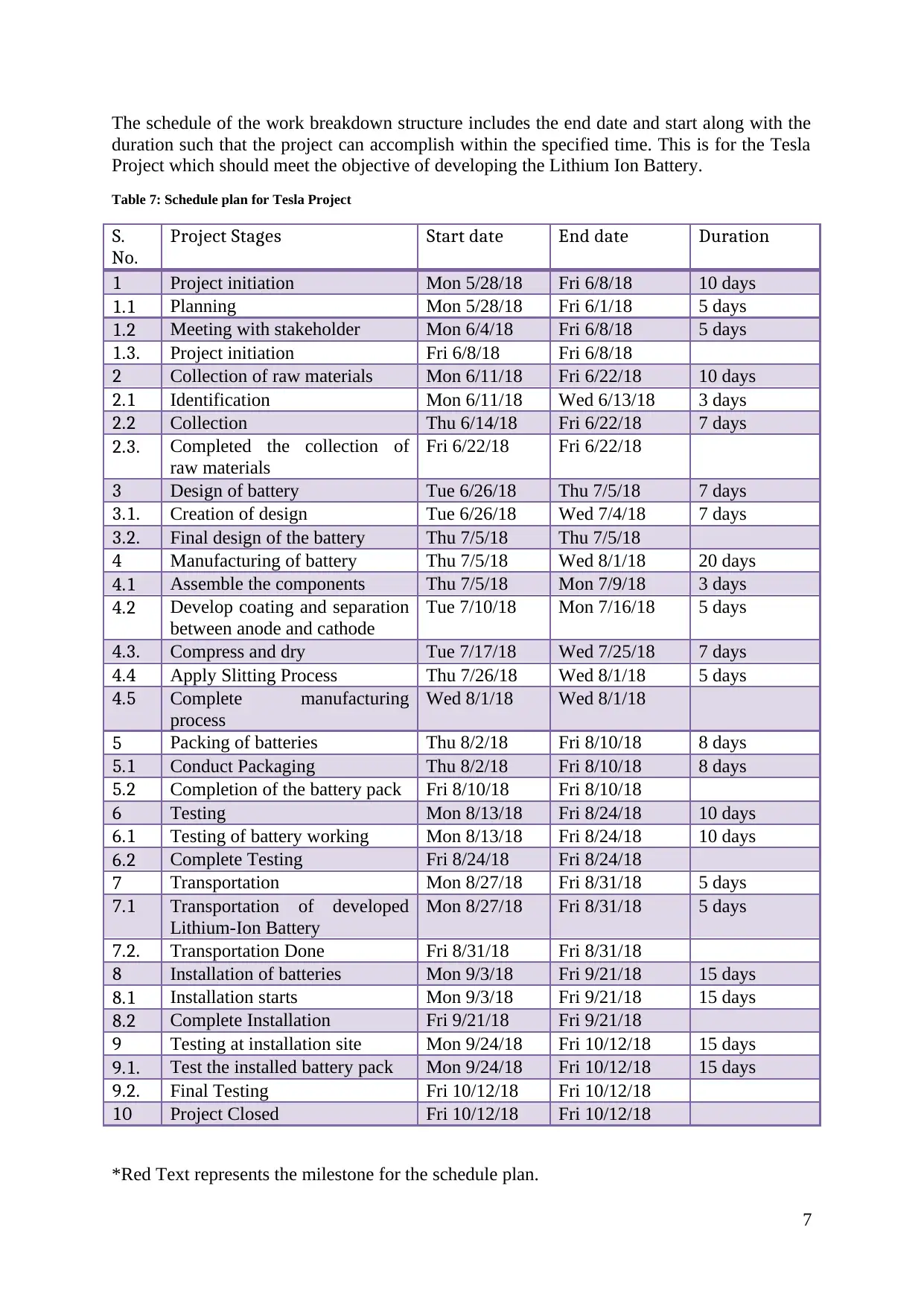
The schedule of the work breakdown structure includes the end date and start along with the
duration such that the project can accomplish within the specified time. This is for the Tesla
Project which should meet the objective of developing the Lithium Ion Battery.
Table 7: Schedule plan for Tesla Project
S.
No.
Project Stages Start date End date Duration
1 Project initiation Mon 5/28/18 Fri 6/8/18 10 days
1.1 Planning Mon 5/28/18 Fri 6/1/18 5 days
1.2 Meeting with stakeholder Mon 6/4/18 Fri 6/8/18 5 days
1.3. Project initiation Fri 6/8/18 Fri 6/8/18
2 Collection of raw materials Mon 6/11/18 Fri 6/22/18 10 days
2.1 Identification Mon 6/11/18 Wed 6/13/18 3 days
2.2 Collection Thu 6/14/18 Fri 6/22/18 7 days
2.3. Completed the collection of
raw materials
Fri 6/22/18 Fri 6/22/18
3 Design of battery Tue 6/26/18 Thu 7/5/18 7 days
3.1. Creation of design Tue 6/26/18 Wed 7/4/18 7 days
3.2. Final design of the battery Thu 7/5/18 Thu 7/5/18
4 Manufacturing of battery Thu 7/5/18 Wed 8/1/18 20 days
4.1 Assemble the components Thu 7/5/18 Mon 7/9/18 3 days
4.2 Develop coating and separation
between anode and cathode
Tue 7/10/18 Mon 7/16/18 5 days
4.3. Compress and dry Tue 7/17/18 Wed 7/25/18 7 days
4.4 Apply Slitting Process Thu 7/26/18 Wed 8/1/18 5 days
4.5 Complete manufacturing
process
Wed 8/1/18 Wed 8/1/18
5 Packing of batteries Thu 8/2/18 Fri 8/10/18 8 days
5.1 Conduct Packaging Thu 8/2/18 Fri 8/10/18 8 days
5.2 Completion of the battery pack Fri 8/10/18 Fri 8/10/18
6 Testing Mon 8/13/18 Fri 8/24/18 10 days
6.1 Testing of battery working Mon 8/13/18 Fri 8/24/18 10 days
6.2 Complete Testing Fri 8/24/18 Fri 8/24/18
7 Transportation Mon 8/27/18 Fri 8/31/18 5 days
7.1 Transportation of developed
Lithium-Ion Battery
Mon 8/27/18 Fri 8/31/18 5 days
7.2. Transportation Done Fri 8/31/18 Fri 8/31/18
8 Installation of batteries Mon 9/3/18 Fri 9/21/18 15 days
8.1 Installation starts Mon 9/3/18 Fri 9/21/18 15 days
8.2 Complete Installation Fri 9/21/18 Fri 9/21/18
9 Testing at installation site Mon 9/24/18 Fri 10/12/18 15 days
9.1. Test the installed battery pack Mon 9/24/18 Fri 10/12/18 15 days
9.2. Final Testing Fri 10/12/18 Fri 10/12/18
10 Project Closed Fri 10/12/18 Fri 10/12/18
*Red Text represents the milestone for the schedule plan.
7
duration such that the project can accomplish within the specified time. This is for the Tesla
Project which should meet the objective of developing the Lithium Ion Battery.
Table 7: Schedule plan for Tesla Project
S.
No.
Project Stages Start date End date Duration
1 Project initiation Mon 5/28/18 Fri 6/8/18 10 days
1.1 Planning Mon 5/28/18 Fri 6/1/18 5 days
1.2 Meeting with stakeholder Mon 6/4/18 Fri 6/8/18 5 days
1.3. Project initiation Fri 6/8/18 Fri 6/8/18
2 Collection of raw materials Mon 6/11/18 Fri 6/22/18 10 days
2.1 Identification Mon 6/11/18 Wed 6/13/18 3 days
2.2 Collection Thu 6/14/18 Fri 6/22/18 7 days
2.3. Completed the collection of
raw materials
Fri 6/22/18 Fri 6/22/18
3 Design of battery Tue 6/26/18 Thu 7/5/18 7 days
3.1. Creation of design Tue 6/26/18 Wed 7/4/18 7 days
3.2. Final design of the battery Thu 7/5/18 Thu 7/5/18
4 Manufacturing of battery Thu 7/5/18 Wed 8/1/18 20 days
4.1 Assemble the components Thu 7/5/18 Mon 7/9/18 3 days
4.2 Develop coating and separation
between anode and cathode
Tue 7/10/18 Mon 7/16/18 5 days
4.3. Compress and dry Tue 7/17/18 Wed 7/25/18 7 days
4.4 Apply Slitting Process Thu 7/26/18 Wed 8/1/18 5 days
4.5 Complete manufacturing
process
Wed 8/1/18 Wed 8/1/18
5 Packing of batteries Thu 8/2/18 Fri 8/10/18 8 days
5.1 Conduct Packaging Thu 8/2/18 Fri 8/10/18 8 days
5.2 Completion of the battery pack Fri 8/10/18 Fri 8/10/18
6 Testing Mon 8/13/18 Fri 8/24/18 10 days
6.1 Testing of battery working Mon 8/13/18 Fri 8/24/18 10 days
6.2 Complete Testing Fri 8/24/18 Fri 8/24/18
7 Transportation Mon 8/27/18 Fri 8/31/18 5 days
7.1 Transportation of developed
Lithium-Ion Battery
Mon 8/27/18 Fri 8/31/18 5 days
7.2. Transportation Done Fri 8/31/18 Fri 8/31/18
8 Installation of batteries Mon 9/3/18 Fri 9/21/18 15 days
8.1 Installation starts Mon 9/3/18 Fri 9/21/18 15 days
8.2 Complete Installation Fri 9/21/18 Fri 9/21/18
9 Testing at installation site Mon 9/24/18 Fri 10/12/18 15 days
9.1. Test the installed battery pack Mon 9/24/18 Fri 10/12/18 15 days
9.2. Final Testing Fri 10/12/18 Fri 10/12/18
10 Project Closed Fri 10/12/18 Fri 10/12/18
*Red Text represents the milestone for the schedule plan.
7
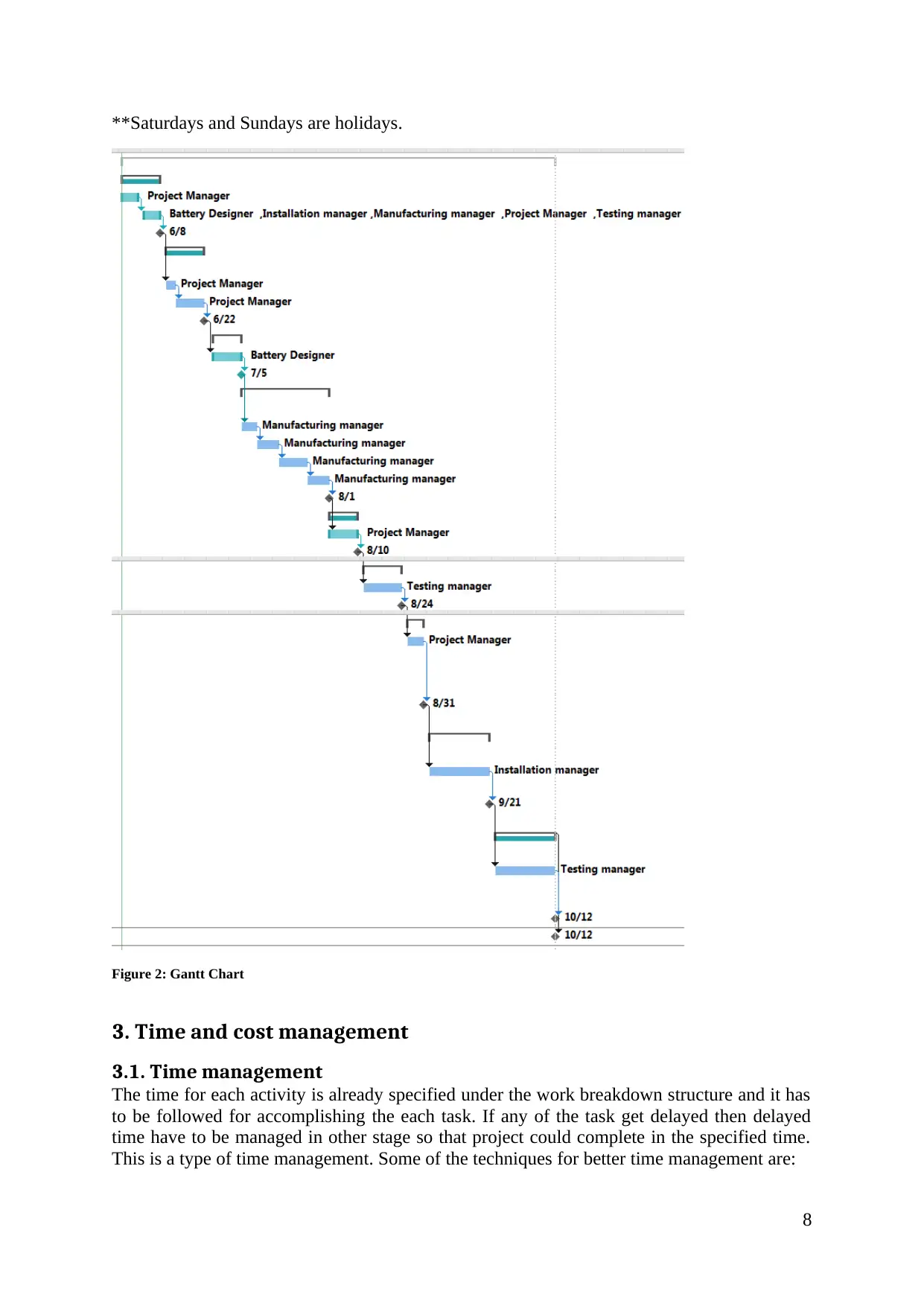
**Saturdays and Sundays are holidays.
Figure 2: Gantt Chart
3. Time and cost management
3.1. Time management
The time for each activity is already specified under the work breakdown structure and it has
to be followed for accomplishing the each task. If any of the task get delayed then delayed
time have to be managed in other stage so that project could complete in the specified time.
This is a type of time management. Some of the techniques for better time management are:
8
Figure 2: Gantt Chart
3. Time and cost management
3.1. Time management
The time for each activity is already specified under the work breakdown structure and it has
to be followed for accomplishing the each task. If any of the task get delayed then delayed
time have to be managed in other stage so that project could complete in the specified time.
This is a type of time management. Some of the techniques for better time management are:
8
⊘ This is a preview!⊘
Do you want full access?
Subscribe today to unlock all pages.

Trusted by 1+ million students worldwide
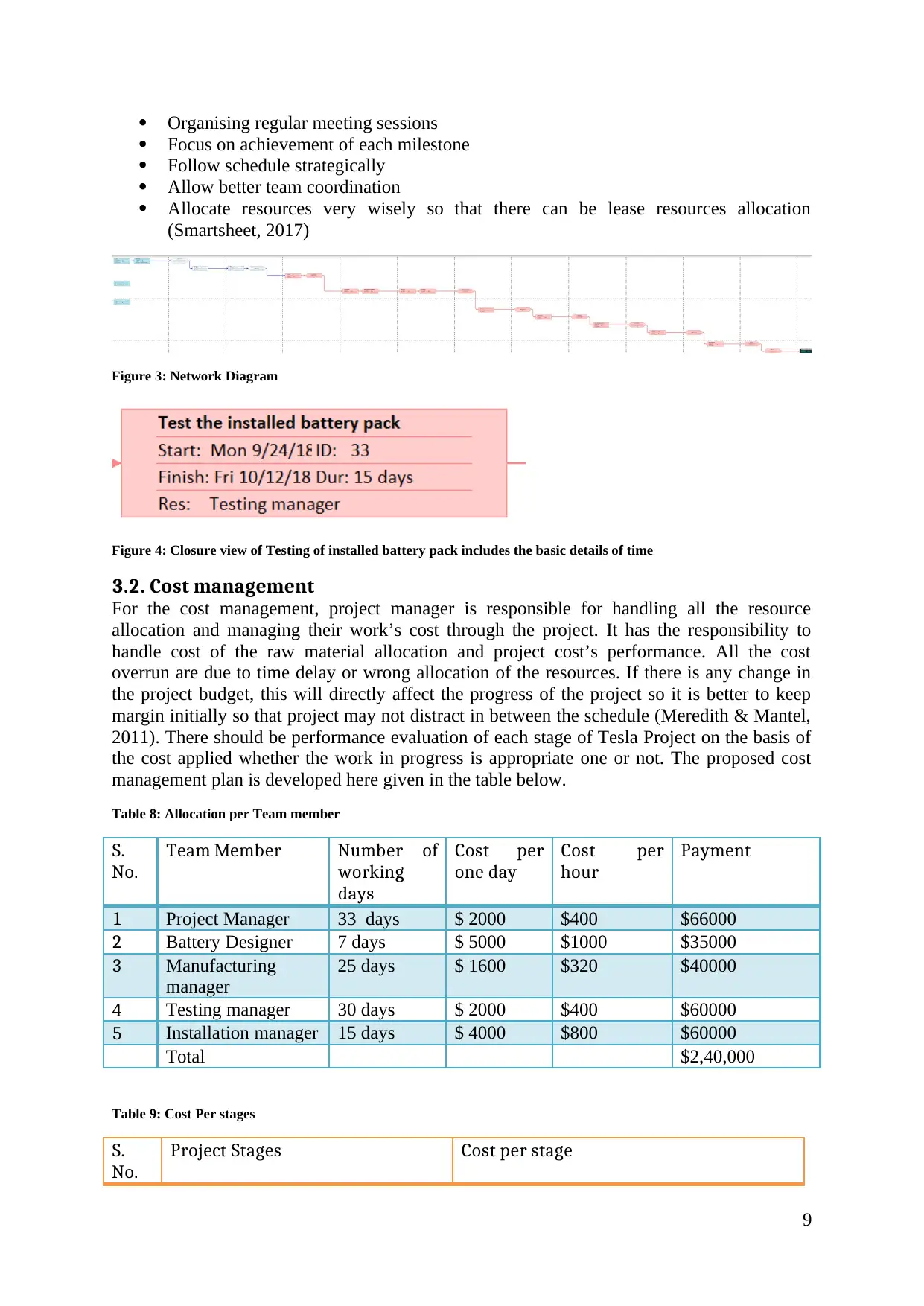
Organising regular meeting sessions
Focus on achievement of each milestone
Follow schedule strategically
Allow better team coordination
Allocate resources very wisely so that there can be lease resources allocation
(Smartsheet, 2017)
Figure 3: Network Diagram
Figure 4: Closure view of Testing of installed battery pack includes the basic details of time
3.2. Cost management
For the cost management, project manager is responsible for handling all the resource
allocation and managing their work’s cost through the project. It has the responsibility to
handle cost of the raw material allocation and project cost’s performance. All the cost
overrun are due to time delay or wrong allocation of the resources. If there is any change in
the project budget, this will directly affect the progress of the project so it is better to keep
margin initially so that project may not distract in between the schedule (Meredith & Mantel,
2011). There should be performance evaluation of each stage of Tesla Project on the basis of
the cost applied whether the work in progress is appropriate one or not. The proposed cost
management plan is developed here given in the table below.
Table 8: Allocation per Team member
S.
No.
Team Member Number of
working
days
Cost per
one day
Cost per
hour
Payment
1 Project Manager 33 days $ 2000 $400 $66000
2 Battery Designer 7 days $ 5000 $1000 $35000
3 Manufacturing
manager
25 days $ 1600 $320 $40000
4 Testing manager 30 days $ 2000 $400 $60000
5 Installation manager 15 days $ 4000 $800 $60000
Total $2,40,000
Table 9: Cost Per stages
S.
No.
Project Stages Cost per stage
9
Focus on achievement of each milestone
Follow schedule strategically
Allow better team coordination
Allocate resources very wisely so that there can be lease resources allocation
(Smartsheet, 2017)
Figure 3: Network Diagram
Figure 4: Closure view of Testing of installed battery pack includes the basic details of time
3.2. Cost management
For the cost management, project manager is responsible for handling all the resource
allocation and managing their work’s cost through the project. It has the responsibility to
handle cost of the raw material allocation and project cost’s performance. All the cost
overrun are due to time delay or wrong allocation of the resources. If there is any change in
the project budget, this will directly affect the progress of the project so it is better to keep
margin initially so that project may not distract in between the schedule (Meredith & Mantel,
2011). There should be performance evaluation of each stage of Tesla Project on the basis of
the cost applied whether the work in progress is appropriate one or not. The proposed cost
management plan is developed here given in the table below.
Table 8: Allocation per Team member
S.
No.
Team Member Number of
working
days
Cost per
one day
Cost per
hour
Payment
1 Project Manager 33 days $ 2000 $400 $66000
2 Battery Designer 7 days $ 5000 $1000 $35000
3 Manufacturing
manager
25 days $ 1600 $320 $40000
4 Testing manager 30 days $ 2000 $400 $60000
5 Installation manager 15 days $ 4000 $800 $60000
Total $2,40,000
Table 9: Cost Per stages
S.
No.
Project Stages Cost per stage
9
Paraphrase This Document
Need a fresh take? Get an instant paraphrase of this document with our AI Paraphraser
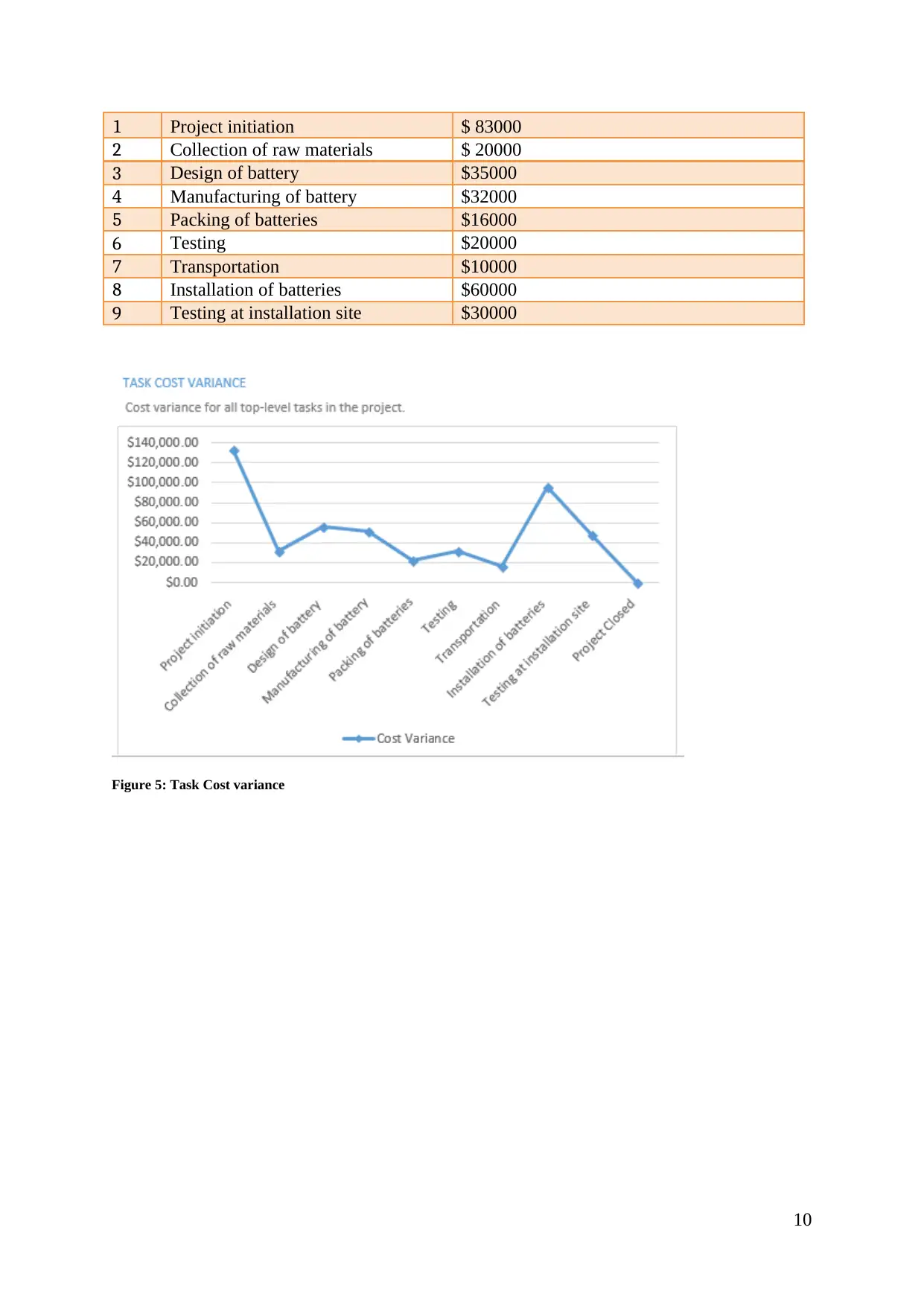
1 Project initiation $ 83000
2 Collection of raw materials $ 20000
3 Design of battery $35000
4 Manufacturing of battery $32000
5 Packing of batteries $16000
6 Testing $20000
7 Transportation $10000
8 Installation of batteries $60000
9 Testing at installation site $30000
Figure 5: Task Cost variance
10
2 Collection of raw materials $ 20000
3 Design of battery $35000
4 Manufacturing of battery $32000
5 Packing of batteries $16000
6 Testing $20000
7 Transportation $10000
8 Installation of batteries $60000
9 Testing at installation site $30000
Figure 5: Task Cost variance
10
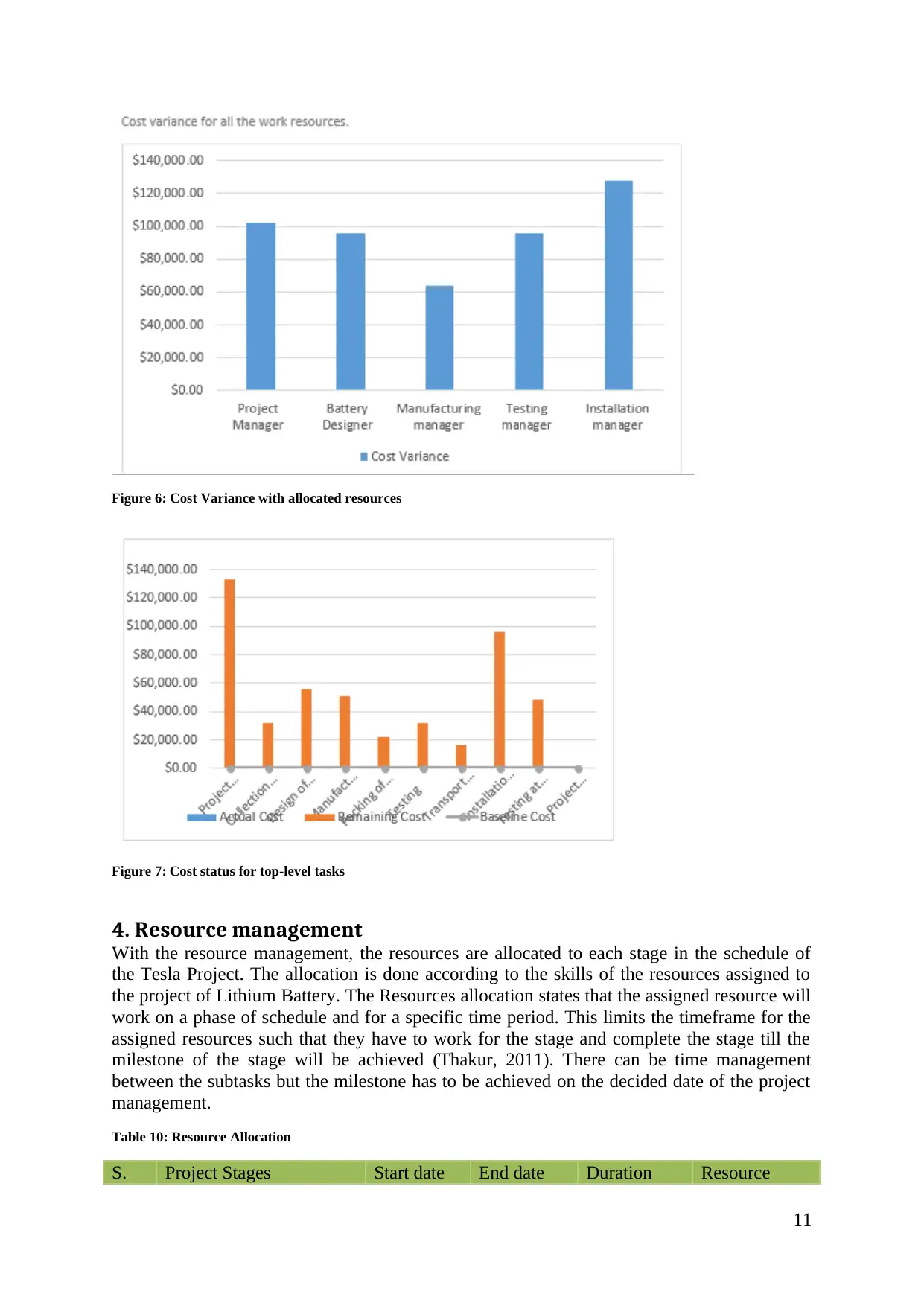
Figure 6: Cost Variance with allocated resources
Figure 7: Cost status for top-level tasks
4. Resource management
With the resource management, the resources are allocated to each stage in the schedule of
the Tesla Project. The allocation is done according to the skills of the resources assigned to
the project of Lithium Battery. The Resources allocation states that the assigned resource will
work on a phase of schedule and for a specific time period. This limits the timeframe for the
assigned resources such that they have to work for the stage and complete the stage till the
milestone of the stage will be achieved (Thakur, 2011). There can be time management
between the subtasks but the milestone has to be achieved on the decided date of the project
management.
Table 10: Resource Allocation
S. Project Stages Start date End date Duration Resource
11
Figure 7: Cost status for top-level tasks
4. Resource management
With the resource management, the resources are allocated to each stage in the schedule of
the Tesla Project. The allocation is done according to the skills of the resources assigned to
the project of Lithium Battery. The Resources allocation states that the assigned resource will
work on a phase of schedule and for a specific time period. This limits the timeframe for the
assigned resources such that they have to work for the stage and complete the stage till the
milestone of the stage will be achieved (Thakur, 2011). There can be time management
between the subtasks but the milestone has to be achieved on the decided date of the project
management.
Table 10: Resource Allocation
S. Project Stages Start date End date Duration Resource
11
⊘ This is a preview!⊘
Do you want full access?
Subscribe today to unlock all pages.

Trusted by 1+ million students worldwide
1 out of 18
Your All-in-One AI-Powered Toolkit for Academic Success.
+13062052269
info@desklib.com
Available 24*7 on WhatsApp / Email
![[object Object]](/_next/static/media/star-bottom.7253800d.svg)
Unlock your academic potential
Copyright © 2020–2025 A2Z Services. All Rights Reserved. Developed and managed by ZUCOL.
